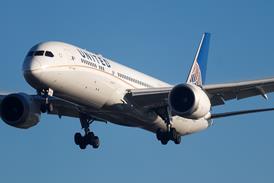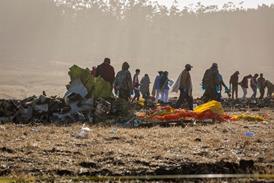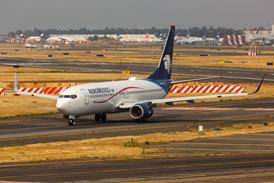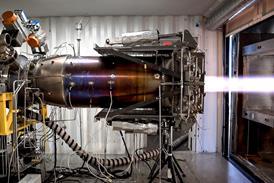MAX KINGSLEY-JONES / NEW YORK
Move to double-daily New York supersonic services delayed as decision looms for expansion of operational fleet
TEXT: With three months of Concorde operations under its belt, British Airways has been generally pleased with the performance of the modified aircraft and the demand for seats since the supersonic aircraft's return to service last November. However, the airline has delayed a planned move to re-introduce double-daily London-New York services, and will this month evaluate whether to expand the operational fleet beyond five aircraft.
Three modified Concordes have been operating since service resumption, and a fourth aircraft will return next month. Each aircraft requires around three months of downtime for the installation of fuel tank liners and other modifications which were called for by the investigation into the crash of an Air France Concorde at Paris in July 2000 (Flight International, 18-31 December 2001).
BA needed a minimum of three Concordes to offer a daily London Heathrow-New York Kennedy service, as it always operates with a back-up aircraft for the outbound service. The fourth aircraft will allow for some rescheduling of services and routine maintenance checks to start on the first three aircraft, as modification of the fifth machine (G-BOAC) begins.
The fifth aircraft is due to return to service in May, and BA had intended to use it to double frequencies across the Atlantic from April, but this has now been delayed until at least the end of the third quarter, says BA Concorde chief pilot Mike Bannister.
BA is generally pleased with the 50-60% load factors that the transatlantic services have been averaging, and in particular a good level of take-up for the less popular eastbound services. Break-even load factor on the 100-seater is widely believed to be around 40 passengers.
A decision on the expansion of frequencies depends on a consistant improvement in load factors and a clearer picture on the general recovery of transatlantic traffic following last September's terrorist attacks. BA is well aware of the business that it lost during the 15 months that Concorde was grounded, as people had to modify their travel and work arrangements to cater for life without the supersonic transport. Bannister says a number of Concorde regulars have come back to the aircraft, grateful for the opportunity to split their working week between Europe and the USA. However, others, who have found different ways to work or travel in its absence, have yet to be enticed back to Concorde.
"Around 80% of our passengers are business people for whom time is money. Some 10-15% are the 'rich and famous' and the remainder are people paying for that 'trip of a lifetime' experience," says Bannister.
The arrival of a fourth modified Concorde enables one aircraft to night-stop in New York, says Bannister, and the return flight to be retimed to an earlier departure (before the inbound aircraft arrives). "The current timing sees us leave New York at 12:15 for a 21:00 arrival in London. We will move to the old timing [prior to the grounding] of 08:30," he says. This earlier departure enables Concorde to arrive in London around 17:00. As well as ensuring that the New York-London service can operate on time regardless of any delay to the outbound flight from London, the earlier timing will be more attractive to passengers as it gets into London that much earlier.
With two of BA's seven Concordes still awaiting conversion, the next decision facing the airline is when to expand the operational fleet further. "We will put our case for the sixth aircraft to BA's Capital Investment Committee later this month," says Bannister. If it is approved, then modification will begin in April and be concluded in August. It is proposed that this aircraft (G-BOAB) will also be the first to be equipped with the new, lighter interior equipment.
Bannister, who served as a technical advisor to the UK Air Accidents Investigation Branch during the crash inquiry, says that the modifications have had little effect on Concorde's performance. "We have completed in-service testing and the test equipment will be removed from Alpha Foxtrot [G-BOAF - the first aircraft modified] this month," says Bannister.
BA Engineering technical and quality director Jim O'Sullivan says: "The equipment was used for various temperature measurements, and to establish if the modifications will have any long-term impact at all on performance and fatigue." Detailed analysis of the data is now under way, he adds.
The tank liners add around 180kg (400lb) to the unusable fuel weight and a 400kg weight penalty. Bannister points out that the new lighter Michelin near zero growth (NZG) radial tyres save around 160kg, and the yet-to-be installed interior saves another 360kg: "So we will end up 140kg better off than before," Bannister says.
The interior has already undergone a cosmetic upgrade with new carpets, curtains and leather Recaro seats. "The weight saving will come from the installation of new galleys and vacuum toilets - the latter will do away with heavy plumbing and reservoirs," O'Sullivan says.
BA decided not to install these items during the early modifications due to the lengthy 21-day installation process required. Each aircraft has to undergo annual inter-checks which require around a month in the hangar, and O'Sullivan says the interior installations are likely to be carried out during this period.
The Michelin NZG tyres are mandatory for the return of Concorde's certificate of airworthiness, as their more supple, radial design makes them far more resistant to foreign object damage than the crossply design previously fitted. "The Michelins are proving much more durable, and we are getting considerably more landings from them," says Bannister.
Bannister says that the build-up of Concorde flight-deck crews is almost complete, with 13 captains, eight co-pilots and 13 flight engineers (FE) now back in harness. Prior to the grounding, the Concorde fleet comprised 21 captains, 14 co-pilots and 24 FEs. Although there are still a handful of captains and FEs to bring back on line, Bannister expects to recruit some additional crews from other fleets as operations expand.
In the late 1990s, BA's Concordes underwent a life extension programme which should keep them flying until around 2010-11, based on current operational projections. In the next four years BA will have to decide whether it wants to develop a second life-extension programme to keep the fleet flying until 2015.
Source: Flight International




















